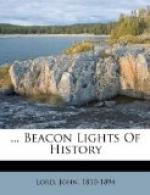But the popes exercised certain powers and prerogatives in England, about the time of Wyclif, which were exceedingly offensive to the secular rulers of the land. They claimed the island as a sort of property which reason and the laws did not justify,—a claim which led to heavy exactions and forced contributions on the English people that crippled the government and impoverished the nation. Boys and favorites were appointed by the popes to important posts and livings. Church preferments were almost exclusively in the hands of the Pope; and these were often bought. A yearly tribute had been forced on the nation in the time of John. Peter’s pence were collected from the people. Enormous sums, under various pretences, flowed to Rome. And the clergy were taxed as well as the laity. The contributions which were derived from the sale of benefices, from investitures, from the transfer of sees, from the bestowal of rings and crosiers (badges of episcopal authority), from the confirmation of elections, and other taxes, irritated sovereigns, and called out the severest denunciation of statesmen.
Closely connected with papal exactions was the enormous increase of the Mendicant friars, especially the Dominicans and Franciscans, who had been instituted by Innocent III. for Church missionary labor. These itinerating preachers in black-and-gray gowns were in every town and village in England. For a century after their institution, they were the ablest and perhaps the best soldiers of the Pope, and did what the Jesuits afterwards performed, and perhaps the Methodists a hundred years ago,—gained the hearts of the people and stimulated religions life; but in the fourteenth century they were a nuisance. They sold indulgences, they invented pious frauds, they were covetous under pretence of poverty, they had become luxurious in their lives, they slandered the regular clergy, they usurped the prerogatives of parish priests, they enriched their convents.
Naturally, Catholic authorities do not admit the extent of degeneration to which these Orders came in their increasing numbers and influence. But other historians strongly represent their evil conduct, which incited the efforts of the early reformers— themselves Catholic. One gets the truest impression of the popular estimate of these friars from the sarcasms of Chaucer. The Friar Tuck whom Sir Walter Scott has painted was a very different man from the Dominicans or the Franciscans of the thirteenth century, when they reigned in the universities, and were the confessors of monarchs and the most popular preachers of their time. In the fourteenth century they were consumed with jealousies and rivalries and animosities against each other; and all the various orders,— Dominican, Franciscan, Carmelite,—in spite of their professions of poverty, were the possessors of magnificent monasteries, and fattened on the credulity of the world. Besides these Mendicant friars,




